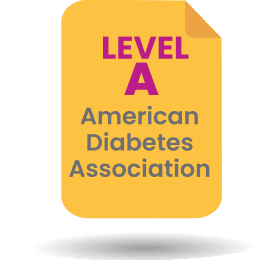For statin intolerant patients, the CV benefit of bempedoic acid is CLEAR1
When no other cardiovascular outcomes trial included patients with statin intolerance—the CLEAR Outcomes trial did1

CLEAR Outcomes is the only CV outcomes trial to study patients with partial or complete statin intolerance at risk of a CV event.1*

Following CLEAR Outcomes, the ADA has updated its guidelines
Bempedoic acid is the only nonstatin with a Level A recommendation† for both primary prevention‡ and secondary prevention§ in statin intolerant patients with diabetes2
Take a closer look at the NEXLETOL study design

Number of patients
13,970

Median duration of follow-up
3.4 years

Patients with diabetes1
46%
77%

Patients with complete statin intolerance1


23%
Patients with partial statin intolerance1
Study Design1,3
Randomized, double-blind, placebo-controlled, CV event-driven trial in 13,970 adult patients who were not receiving recommended statin therapy, and who had CVD or were at high risk for a CVD event based on meeting at least one of the following criteria: (1) diabetes mellitus (type 1 or type 2) in females over 65 years of age, or males over 60 years of age; (2) a Reynolds risk score >30% or a SCORE risk score >7.5% over 10 years; (3) a coronary artery calcium score >400 Agatston units at any time in the past. Patients were randomized to receive once-daily NEXLETOL 180 mg (n=6992) or placebo (n=6978). Patients were followed for at least 24 months after randomization and treated until at least 1620 patients experienced a MACE-4 endpoint and at least 810 patients experienced a MACE-3 endpoint.
Choose NEXLIZET or NEXLETOL for managing statin intolerance
Treating patients with statin intolerance can be challenging. But NEXLIZET and NEXLETOL are the only FDA-approved products|| to reduce the risk of MI and coronary revascularization in primary prevention and secondary prevention patients with partial or complete statin intolerance.¶
Patients can’t take a statin? Make NEXLIZET happen!
CV outcomes in statin intolerance

Only the CLEAR Outcomes trial studied and demonstrated the impact of bempedoic acid on cardiovascular risk in statin intolerant patients.1,3
The nonstatin difference

NEXLIZET and NEXLETOL contain bempedoic acid, which works differently than statins and is not active in skeletal muscle.3-5
Studied in patients like yours

This global study evaluated both primary and secondary prevention populations.1,3
*CLEAR Outcomes enrolled 14,000 patients unable to take recommended statin therapy to evaluate reduction in risk of MACE-4 (time to first occurrence of nonfatal MI, coronary revascularization, nonfatal stroke, or CV death).1,3
†Level A recommendations from the ADA are based on clear evidence from well-conducted, generalizable, randomized, controlled trials that are adequately powered.2
‡CV risk and LDL-C reduction.2
§LDL-C reduction.2
||Bempedoic acid.1
¶The NLA defines partial statin intolerance as the ability to tolerate a lower dose of statin than is required to achieve the desired therapeutic objective, and complete statin intolerance as the inability to tolerate any dose or regimen of a statin.6
Interested in samples?
Get patients started with a 14-day sample of NEXLIZET or NEXLETOL.
Request SamplesINDICATION AND IMPORTANT SAFETY INFORMATION
Indication
NEXLIZET and NEXLETOL are indicated:
- The bempedoic acid component of NEXLIZET and NEXLETOL is indicated to reduce the risk of myocardial infarction and coronary revascularization in adults who are unable to take recommended statin therapy (including those not taking a statin) with:
- established cardiovascular disease (CVD), or
- at high risk for a CVD event but without established CVD.
- As an adjunct to diet:
- NEXLIZET, alone or in combination with other LDL-C lowering therapies, to reduce LDL-C in adults with primary hyperlipidemia, including HeFH.
- NEXLETOL, in combination with other LDL-C lowering therapies, or alone when concomitant LDL-C lowering therapy is not possible, to reduce LDL-C in adults with primary hyperlipidemia, including HeFH.
IMPORTANT SAFETY INFORMATION
NEXLIZET and NEXLETOL are contraindicated in patients with a prior hypersensitivity to bempedoic acid or ezetimibe or any of the excipients. Serious hypersensitivity reactions including anaphylaxis, angioedema, rash, and urticaria have been reported.
Hyperuricemia : Bempedoic acid, a component of NEXLIZET and NEXLETOL, may increase blood uric acid levels, which may lead to gout. Hyperuricemia may occur early in treatment and persist throughout treatment, returning to baseline following discontinuation of treatment. Assess uric acid levels periodically as clinically indicated. Monitor for signs and symptoms of hyperuricemia, and initiate treatment with
Tendon Rupture : Bempedoic acid, a component of NEXLIZET and NEXLETOL, is associated with an increased risk of tendon rupture or injury. Tendon rupture may occur more frequently in patients over 60 years of age, in those taking corticosteroid or fluoroquinolone drugs, in patients with renal failure, and in patients with previous tendon disorders. Discontinue NEXLIZET or NEXLETOL at the first sign of tendon rupture. Consider alternative therapy in patients who have a history of tendon disorders or tendon rupture.
The most common adverse reactions in the primary hyperlipidemia trials of bempedoic acid, a component of NEXLIZET and NEXLETOL, in ≥2% of patients and greater than placebo were upper respiratory tract infection, muscle spasms, hyperuricemia, back pain, abdominal pain or discomfort, bronchitis, pain in extremity, anemia, and elevated liver enzymes.
Adverse reactions reported in ≥2% of patients treated with ezetimibe (a component of NEXLIZET) and at an incidence greater than placebo in clinical trials were upper respiratory tract infection, diarrhea, arthralgia, sinusitis, pain in extremity, fatigue, and influenza.
In the primary hyperlipidemia trials of NEXLIZET, the most commonly reported adverse reactions (incidence ≥3% and greater than placebo) observed with NEXLIZET, but not observed in clinical trials of bempedoic acid or ezetimibe, were urinary tract infection, nasopharyngitis, and constipation.
The most common adverse reactions in the cardiovascular outcomes trial for bempedoic acid, a component of NEXLIZET and NEXLETOL, at an incidence of ≥2% and 0.5% greater than placebo were hyperuricemia, renal impairment, anemia, elevated liver enzymes, muscle spasms, gout, and cholelithiasis.
Concomitant use of NEXLIZET or NEXLETOL with greater than 20 mg of simvastatin or 40 mg of pravastatin should be avoided due to the potential for increased risk of simvastatin- or pravastatin-related myopathy.
Discontinue NEXLIZET or NEXLETOL when pregnancy is recognized unless the benefits of therapy outweigh the potential risks to the fetus. Because of the potential for serious adverse reactions in a breast-fed infant, breastfeeding is not recommended during treatment with NEXLIZET or NEXLETOL.
Report pregnancies to Esperion Therapeutics, Inc. Adverse Event reporting line at at 1-833-377-7633.
Please see full Prescribing Information for NEXLIZET and NEXLETOL.
INDICATION AND IMPORTANT SAFETY INFORMATION
Indication
NEXLIZET and NEXLETOL are indicated:
- The bempedoic acid component of NEXLIZET and NEXLETOL is indicated to reduce the risk of myocardial infarction and coronary revascularization in adults who are unable to take recommended statin therapy (including those not taking a statin) with:
- established cardiovascular disease (CVD), or
- at high risk for a CVD event but without established CVD.
- As an adjunct to diet:
- NEXLIZET, alone or in combination with other LDL-C lowering therapies, to reduce LDL-C in adults with primary hyperlipidemia, including HeFH.
- NEXLETOL, in combination with other LDL-C lowering therapies, or alone when concomitant LDL-C lowering therapy is not possible, to reduce LDL-C in adults with primary hyperlipidemia, including HeFH.
IMPORTANT SAFETY INFORMATION
NEXLIZET and NEXLETOL are contraindicated in patients with a prior hypersensitivity to bempedoic acid or ezetimibe or any of the excipients. Serious hypersensitivity reactions including anaphylaxis, angioedema, rash, and urticaria have been reported.
Hyperuricemia : Bempedoic acid, a component of NEXLIZET and NEXLETOL, may increase blood uric acid levels, which may lead to gout. Hyperuricemia may occur early in treatment and persist throughout treatment, returning to baseline following discontinuation of treatment. Assess uric acid levels periodically as clinically indicated. Monitor for signs and symptoms of hyperuricemia, and initiate treatment with
Tendon Rupture : Bempedoic acid, a component of NEXLIZET and NEXLETOL, is associated with an increased risk of tendon rupture or injury. Tendon rupture may occur more frequently in patients over 60 years of age, in those taking corticosteroid or fluoroquinolone drugs, in patients with renal failure, and in patients with previous tendon disorders. Discontinue NEXLIZET or NEXLETOL at the first sign of tendon rupture. Consider alternative therapy in patients who have a history of tendon disorders or tendon rupture.
The most common adverse reactions in the primary hyperlipidemia trials of bempedoic acid, a component of NEXLIZET and NEXLETOL, in ≥2% of patients and greater than placebo were upper respiratory tract infection, muscle spasms, hyperuricemia, back pain, abdominal pain or discomfort, bronchitis, pain in extremity, anemia, and elevated liver enzymes.
Adverse reactions reported in ≥2% of patients treated with ezetimibe (a component of NEXLIZET) and at an incidence greater than placebo in clinical trials were upper respiratory tract infection, diarrhea, arthralgia, sinusitis, pain in extremity, fatigue, and influenza.
In the primary hyperlipidemia trials of NEXLIZET, the most commonly reported adverse reactions (incidence ≥3% and greater than placebo) observed with NEXLIZET, but not observed in clinical trials of bempedoic acid or ezetimibe, were urinary tract infection, nasopharyngitis, and constipation.
The most common adverse reactions in the cardiovascular outcomes trial for bempedoic acid, a component of NEXLIZET and NEXLETOL, at an incidence of ≥2% and 0.5% greater than placebo were hyperuricemia, renal impairment, anemia, elevated liver enzymes, muscle spasms, gout, and cholelithiasis.
Concomitant use of NEXLIZET or NEXLETOL with greater than 20 mg of simvastatin or 40 mg of pravastatin should be avoided due to the potential for increased risk of simvastatin- or pravastatin-related myopathy.
Discontinue NEXLIZET or NEXLETOL when pregnancy is recognized unless the benefits of therapy outweigh the potential risks to the fetus. Because of the potential for serious adverse reactions in a breast-fed infant, breastfeeding is not recommended during treatment with NEXLIZET or NEXLETOL.
Report pregnancies to Esperion Therapeutics, Inc. Adverse Event reporting line at at 1-833-377-7633.
Please see full Prescribing Information for NEXLIZET and NEXLETOL.
ADA=American Diabetes Association; CV=cardiovascular; HeFH=heterozygous familial hypercholesterolemia; LDL-C=low-density lipoprotein cholesterol; MACE=major adverse cardiovascular event; MI=myocardial infarction.
References
1. Nissen SE, Lincoff DB, Ray KK, et al. Bempedoic acid and cardiovascular outcomes in statin-intolerant patients. N Engl J Med. 2023;388:1353-1364. 2. American Diabetes Association Professional Practice Committee. 10. Cardiovascular disease and risk management: standards of care in diabetes—2025. Diabetes Care. 2025;48(suppl 1):S207-S238. 3. NEXLETOL. Prescribing information. Esperion Therapeutics, Inc. 4. NEXLIZET. Prescribing information. Esperion Therapeutics, Inc. 5. Pinkosky SL, et al. Nat Commun. 2016;7(13457):1-13. 6. Cheeley MK, Saseen JJ, Agarwala A, et al. NLA scientific statement on statin intolerance: a new definition and key considerations for ASCVD risk reduction in the statin intolerant patient. J Clin Lipidol. 2022;16:361-375.